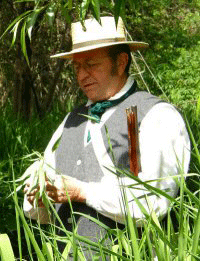David Douglas, the Scottish botanist, traversed the Columbia River Plateau in 1825-1827. He wrote about an encounter near the Celilo Falls or the “Great Falls” in June 1825, when his party was threatened by Indians.
“Just at this time a chief of the Kyeuuse tribe and three of his young men, who are the terror of all other tribes west of the mountains and great friends of the white people, as they call them, stepped in and settled the matter in a few words without any further trouble. This very friendly Indian, who is the finest figure of a man that I have seen, standing nearly 6 feet 6 inches high, accompanied us a few miles up the river, where we camped for the night, after being remunerated by Mr. McLeod for his friendship—I being King George’s Chief or the Grass Man, as I am called. I bored a hole in the only shilling I had, one which has been in my pocket since I left London, and, the septum of his nose being perforated, I suspended it to it with a brass wire. This was to him the great seal of friendship. After smoking, he returned to the Indian village and promised that he would not allow us to be molested.” David Douglas, March 24, 1826, Journal.
This is similar to what the artist Paul Kane would eventually write about his encounter in 1847, “These Indians, the Kye-use, resemble the Walla-Wallas very much. They are always allies in war, and their language and customs are almost identical, except that the Kye-use Indians are far more vicious and ungovernable.” Paul Kane’s Great Nor-West.
It’s interesting to catch a glimpse of the ancestors through the eyes of itinerant scientists and artists of the period. Their occupations should give them some credence for accuracy in observation. They were firsthand witnesses, however transient they were. Some contemporary scholars discount the likelihood that Cayuse Indians had much influence on neighboring Tribes.
Douglas wrote about how Indians perceived him as well. “My canoe-men and guides were much surprised to see me make an effervescent draught and drink it boiling, as they thought it. They think there are good and bad spirits, and that I belong to the latter class, in consequence of drinking boiling water, lighting my tobacco pipe with my lens and the sun, and they call me Olla-piska, which in the Chenook tongue signifies fire. But above all, to place a pair of spectacles on the nose is beyond all their comprehension; they immediately place the hand tight on the mouth, a gesture of dread or astonishment.”
Douglas writes offhandedly about killing a white-headed eagle and eating it for dinner. He was always blasting animals out of the air, then finding them too damaged to preserve. He was a big collector of species both flora and fauna. He built quite a body of work categorizing all sorts of things. He went through many privations just like the Indians, such as sore sand-blasted eyes, which he treated with drops of opium. After leaving the Columbia River, he ended up in Hawaii where he died at the age of 35 a few years later.

